Gutsiest Moves in Packaging Sustainability this Year
Which one do you think deserves top billing? Vote now to help pick the winner.

It takes a gutsy move to make a difference sometimes.
Look at these five courageous actions companies are taking to help achieve their professed sustainability goals, woo a cadre of customers, and save the planet.
After reading through the stories, vote for which move you think is the gutsiest.
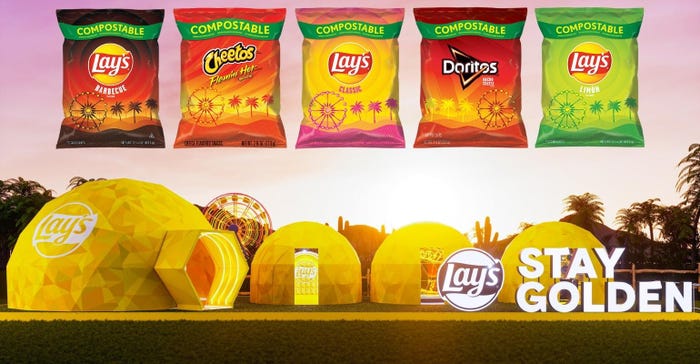
PepsiCo
1. The Move: PepsiCo’s commitment to compostable packaging.
In April, PepsiCo officially opened its Greenhouse Learning Center at its Frito-Lay campus in Plano, TX. This is also where the Packaging R&D lab does research and testing for PepsiCo’s Frito-Lay and Quaker business groups. The idea is that they’ll be able to test new packaging materials for their compostability much quicker than if they had to use an outside service/lab.
This was the latest in the company’s decade-long-plus journey with compostable packaging. You may recall the commercially unsuccessful launch of compostable packaging for its Sun Chips snacks in 2010. I say commercially unsuccessful because it was fruitful as a learning opportunity for what’s possible. They kept working on it and have a new version of the film structure in the marketplace today. In the spring of 2022, PepsiCo tested compostable packaging at the Coachella Valley annual music and arts festival. And another compostable bag is on shelves at Whole Foods for the Off the Eaten Path product, for certain stock-keeping units.
Back to this year’s move … at the official opening of the Greenhouse Learning Center, PepsiCo also revealed a new focus on home-compostable packaging. The idea being that, packaging that composts in what’s considered a “cold” composting environment will also break down in a “hot” industrial compost, but not vice versa. So designing for worst-case scenario means the packaging will decompose in any compost environment, expanding its end-of-life disposal options.
Why It’s Gutsy: The US currently does not have an infrastructure for composting used packaging at volume for consumers. And curbside collection, to make it easy for consumers to compost, is virtually non-existent. According to BPI, there are almost 5,000 composting facilities in the US today. However, most accept only yard waste. According to The Composting Consortium, about 70% of the 200 full-scale composting facilities in the US that process food waste also process some form of compostable packaging.
That being said … PepsiCo has to do something to achieve its goal of designing all packaging to be recyclable, reusable, compostable, or biodegradable by 2025. This goal is part of the company’s ambitious sustainability initiative called pep+, which was introduced in 2021.
Other companies are hyper focused on packaging recyclability, but that’s more challenging for PepsiCo because so much of its packaging is multilayer flexible packaging, which is needed to provide adequate oxygen and moisture barrier for the company’s food products. This barrier is critical to ensure long enough shelf life so the food doesn’t go to waste before it can be eaten.
Mechanical recycling isn’t a viable option for multilayer flexible packaging because of its multiple materials. But Denise Lefebvre, PepsiCo’s Senior Vice President of R&D, tells us the thin metallization layer doesn’t impair compostability, according to certification body BPI. Hence, PepsiCo’s investment in compostable packaging despite the lack of infrastructure in the US.
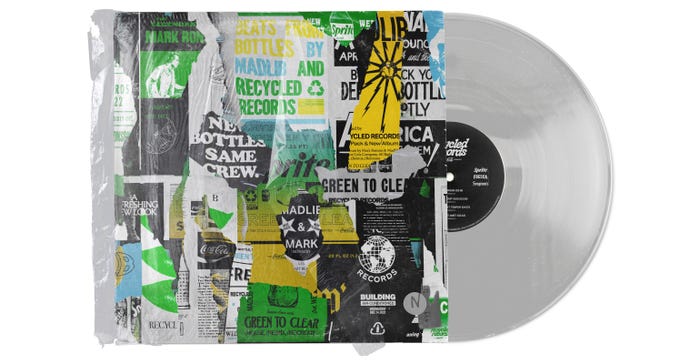
Coca-Cola
2. The Move: Coca-Cola’s switch to clear PET.
The 2023 Recycled Records marketing campaign celebrated Coca-Cola’s 2022 switch from green polyethylene terephthalate (PET) to clear PET bottles for soft-drink brands Sprite, Fresca, Seagram’s Ginger Ale, and Mello Yello.
Through the campaign, Coca-Cola explained to consumers that, after recycling, green PET is typically remanufactured into items like clothing and carpeting, but not into new PET bottles. Clear PET, on the other hand, can be recycled and made into new beverage bottles over and over again. The switch to clear PET supports bottle-to-bottle recycling and a circular economy for PET beverage bottles.
The digital campaign educated consumers about beverage packaging recycling while also capturing their musical imagination: The campaign posits that bottle-to-bottle recycling is like composing music that incorporates samples of previously recorded music or sounds. Thus, the centerpiece of Recycled Records is a digital extended play (EP) recording filled with samples of sounds recorded at recycling centers across the US.
The goal was to bring awareness to this packaging change and encourage consumers to recycle Coca-Cola bottles.
Why It’s Gutsy: Coca-Cola’s bottles are still plastic! They are still single use! But clear PET is still the right package for the use-case, in my opinion. Explaining to consumers what they did — and why — as clearly, simply, and entertainingly as possible made this a winning move. Getting people to feel good about participating in recycling connects with them emotionally and builds brand affinity.
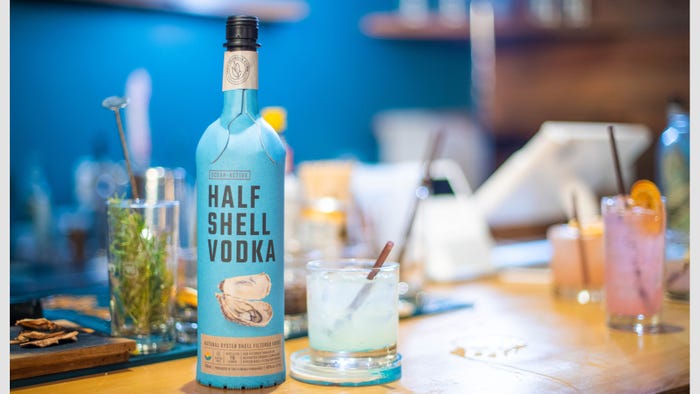
Distillery 98
3. The Move: Paper bottles for beverages.
Development of paper bottles has been in the works for years. Some products were finally available for sale to consumers in 2023. For example, Distillery 98 launched its Half Shell Vodka in the radically distinctive Frugalpac paper bottle (above); and paper cans of Splash Beverages’ Pulpoloco Sangria made a splash in the US with distribution to 7-Eleven and other retail outlets this year (below).
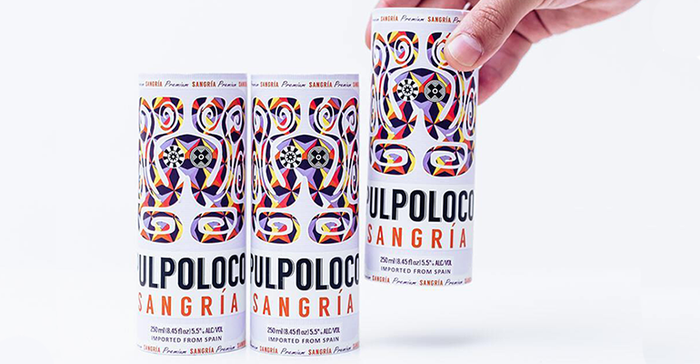
Splash Beverages
Why It’s Gutsy: Because they're so new, the functionality of and consumer preference for paper bottles is relatively unknown. Will people like the experience of drinking from paper packaging and the “taste” of the beverage once the novelty that it’s a “sustainable” package wears off? Brands need to do more organoleptic testing.
There’s no denying the popularity of paper packaging these days. But it’s good to question its performance, especially for foods and beverages.
Eastman
4. The Move: J&J’s advanced recycling packaging investment.
At the 2023 thePACKout conference, we heard about J&J Ethicon’s project with Eastman for its medical device sterile-barrier packaging. Ethicon is the first medical device maker to source Eastman’s Eastar Renew 6763 resin. Eastar Renew 6763 is indistinguishable from the Eastar 6763 copolyester medical device manufactures have used for decades. Renew polymers are produced with circular content by mass balance allocation that is certified by the global independent agency International Sustainability & Carbon Certification (ISCC).
To be clear, J&J made zero changes to its medical-device packaging. However, on paper, it is supporting advanced recycling (also known as molecular recycling) and certifying that, by sourcing Eastar Renew, it is helping divert plastic waste from landfills, which is then used to produce new packaging for someone else.
This is similar to the concept of buying carbon credits to offset your carbon footprint while making no changes to your consumption.
The partners believe this is an important first step toward achieving circularity for healthcare packaging.
Why It’s Gutsy: J&J didn’t change its packaging at all but touts the move as a no-brainer to help the company improve the sustainability of its medical device packaging.
How will this be perceived by customers and market players? Will this be considered greenwashing or a needed investment in promising technology?
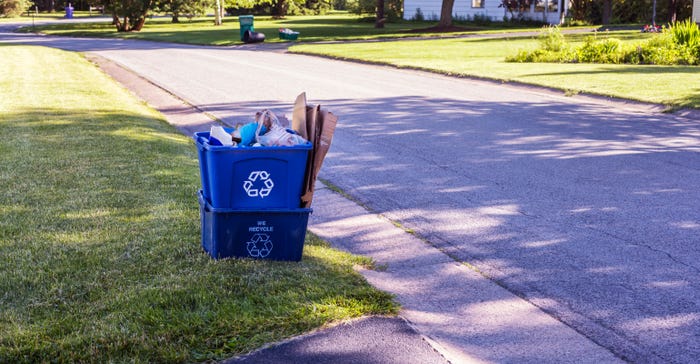
Willowpix / iStock via Getty Images Plus
5. The Move: Flexible packaging curbside recycling.
This year, we saw some success with programs to recycle flexible packaging at curbside. Resource Recycling Systems (RRS) completed its Materials Recovery for the Future Project. The two-year project that investigated the viability of curbside recycling of flexible packaging determined that it is, indeed, “practical and economically feasible.”
Why It’s Gutsy: Municipal recyclers don’t accept films because they can’t handle them mechanically, automatically. And there is not enough interest in the recyclate to make this type of material profitable for recyclers.
But with so much flexible packaging being used these days, and ultimately showing up in consumers’ waste streams, it’s time to tackle the challenges and make curbside collection a reality.

Amazon
6. The Move: Amazon going plastic-packaging free.
Amazon’s automated fulfillment center in Euclid, OH, eliminated plastic delivery packaging as part of a transition to paper-based, curbside-recyclable shipping materials at the company’s US fulfillment centers.
Why It’s Gutsy: In many cases, paper packaging is heavier than a comparable plastics solution, and often also bulkier, to provide the same cushioning protection for products. With Amazon Prime members getting free shipping for many products, the company will likely see its shipping costs rise as weights/Dim Weights rise.
I’m not worried Amazon will go out of business because paper packaging will erode its profits. But I do see this as a gutsy move.
VOTE NOW! And see the results!
About the Author(s)
You May Also Like




